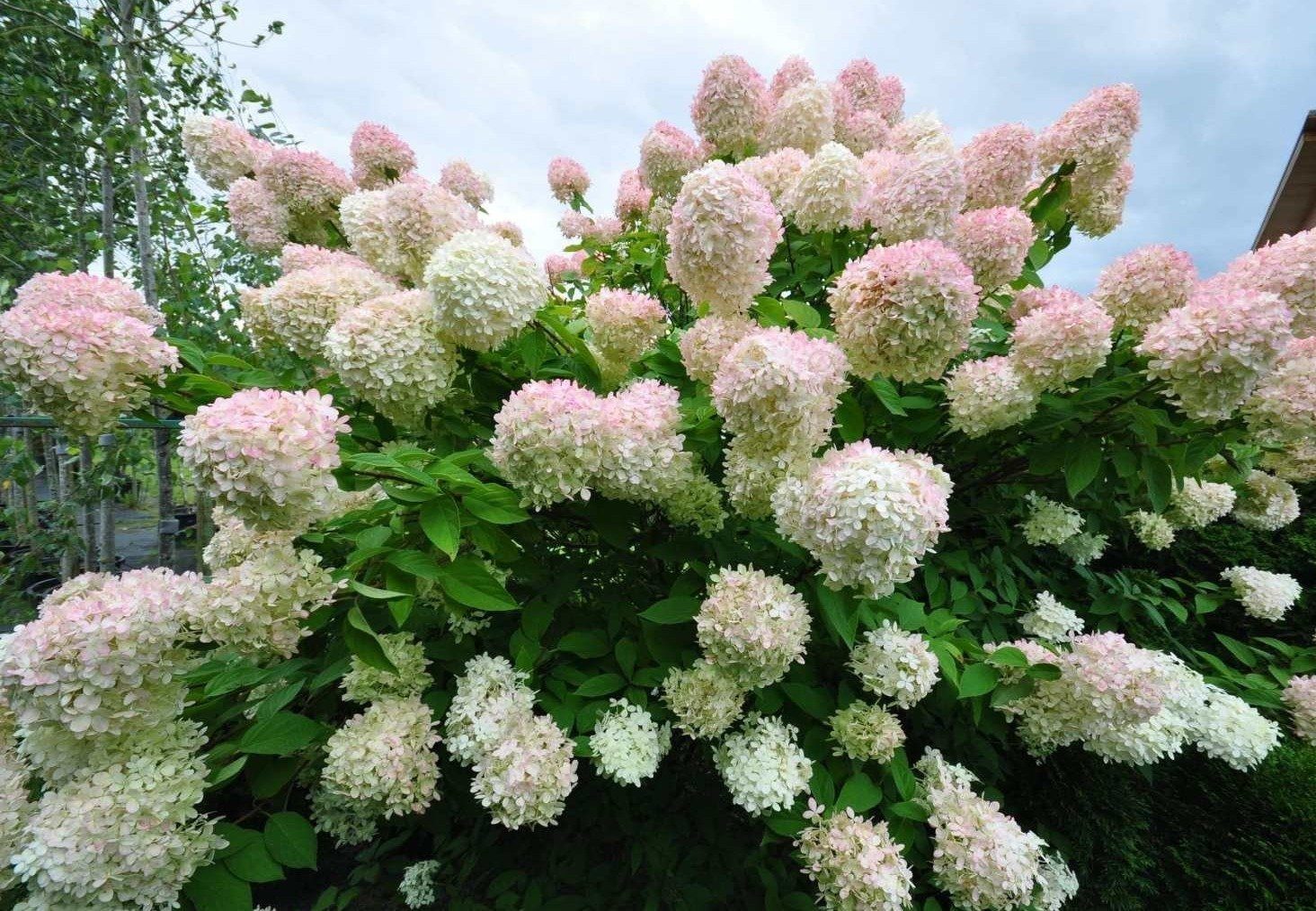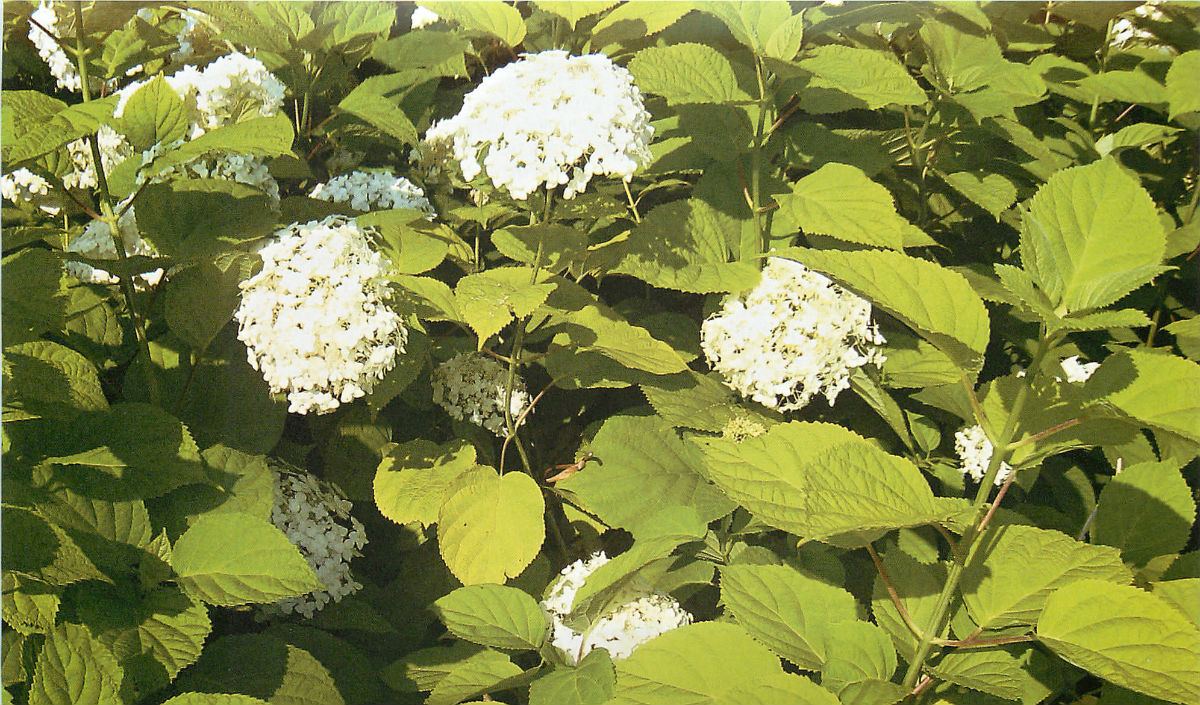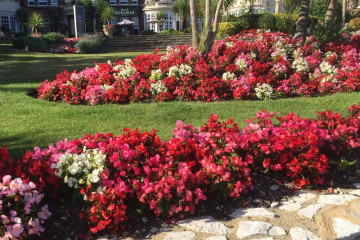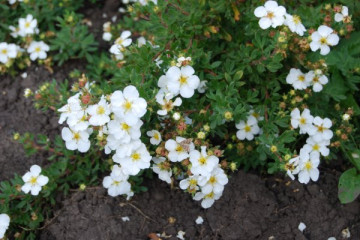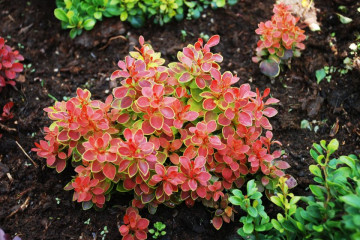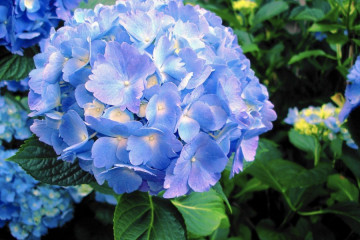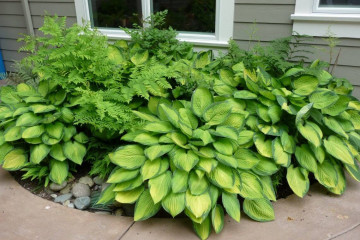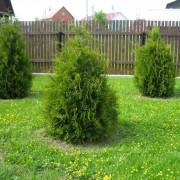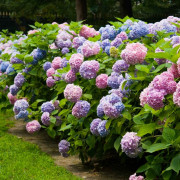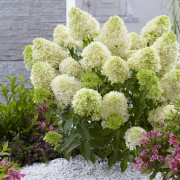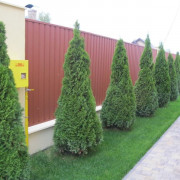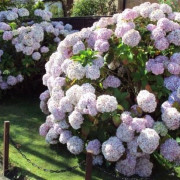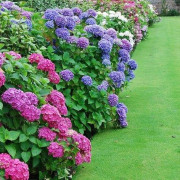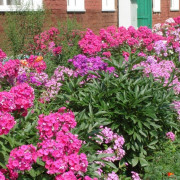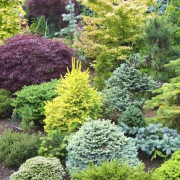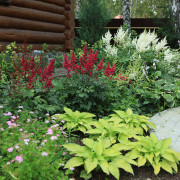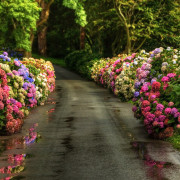Hydrangea varieties and types for Russian gardens
Content:
A stunningly beautiful plant, hydrangea, is grown in garden plots and is a bright accent in landscape compositions. Hydrangea varieties are diverse, so each grower can choose the appropriate option according to his own taste. And thanks to the achievements of modern breeding, many varieties of the plant are distinguished by frost resistance, immunity to diseases and improved decorativeness.
General description of the shrub
Although the hydrangea is sometimes cultivated as a tree by inexperienced gardeners, it is a bush. Botanical features:
- Egg-shaped leaves.
- The flowers are large, have 4 sepals, resembling petals. The color can be anything from snow-white and blood-red to amazing blue, purple, greenish.
- Some types of hydrangeas can be cultivated as small trees.
- In nature, the height reaches 3 meters, but in gardens and in private plots, the height rarely exceeds 1.5 meters.
In the natural environment, a large number of different varieties of hydrangea are found in China, Japan, and other Asian states. The plant prefers light partial shade and a normal level of humidity - a dry climate is destructive for them.
Brief description of the main types
The world's most popular perennial varieties are paniculate, tree and garden hydrangeas. All of them are distinguished by good decorative characteristics, compact bushes, perfectly adapt to the climate of central Russia and even endure Russian winters staunchly.
Paniculata
Latin name - H. Paniculatasieb. The natural habitat of this beautiful plant with soft pink lush inflorescences is Japan.
Botanical characteristics:
- The height of the bush is 1.5 meters;
- The flowering is very lush and friendly.
- Flowers are collected in inflorescence balls. The diameter of the inflorescence is up to 25 cm.
- At first, the petals are white, with a slight greenish tinge, but gradually acquire an elegant pink color.
- A powerful root system, its diameter is much larger than the diameter of the crown. Therefore, when digging the soil, care must be taken so as not to harm the culture. The roots are very close to the ground.
In the wild, panicle hydrangea is often a small tree. It is found in China, Japan, as well as in the Far East. A popular variety of paniculate flower is Dolly, unpretentious to care for, but very attractive.
These are the early flowering plants.
Tree-like
You can also find the name in Latin H. arborescens l. The homeland of the variety is the North American continent. This is a small tree, not exceeding 1 meter high. Lancet leaves are its decorative decoration. Lush bloom lasts for 3 months, covering the period from the second week of July to mid-October.
Many varieties are excellent for growing in the middle lane, since they are frost-resistant.
Among flower growers, the Anabel variety is especially fond of, the main wealth of which is the snow-white lush caps of the inflorescences (diameter - 26 cm). In addition, Anabel is undemanding to care for, feels comfortable on neutral soils or soils with weak acidity.
Garden (large-leaved)
The variety is suitable for the climate of the Moscow region, it is distinguished by a long elegant flowering: almost all summer this amazing hydrangea will delight its owner with lush elegant caps of inflorescences. Perennial plant, decorated with ovoid leaves.
Features of the variety:
- The diameter of the inflorescence is about 3 cm.
- The height of the shrub is 2 meters.
- The fruit is a capsule that appears after flowering is complete.
An example of a variety - Endless summer, with very large inflorescences. A frost-resistant variety, but loves moisture very much; if watering is insufficient, it can die.
Pereshkovaya
This is an unusual hydrangea - not a bush, but a perennial liana, characterized by increased decorativeness. In the wild, its length can exceed 25 meters, but at home it rarely grows to 3 meters.
Attaches to the surface with air spines. Differs in pale rounded leaves. The flowers are greenish-white or pink, and may be light lavender. Collected in an inflorescence with a diameter of 15-27 cm.
Flowering occurs in the second half of summer and ends with the arrival of autumn frosts. The variety tolerates the winters of the middle zone well, but in more northern latitudes it can freeze.
Despite its unpretentiousness, it is quite rare in the areas. The reason is in an unusual form. Two methods are suitable for reproduction - cuttings and seed.

Curly petioled hydrangea will help to tastefully decorate the appearance of country houses and gazebos
Rough
Perennial shrub more than 2 meters high, leaves are thick, velvety to the touch, hence the name. Inflorescences are large, but flat, color options are white, lilac. The plant tolerates the vagaries of the weather and frost well, therefore it is actively cultivated in the middle lane.
Flowering lasts from the last days of July to mid-September. For the growth of such hydrangeas, a site in a bright, sun-drenched place with light penumbra is suitable. Protection from winds and groundwater is mandatory. The soil needs light nutritious.
Dubolistnaya
A very elegant and attractive plant, the leaves of which are similar to those of oak, hence the name. The shrub reaches a height of 1.5 meters.
Features:
- The leaf plates are large.
- Paniculate inflorescences.
Growing in the middle lane, it does not have time to bloom due to the specifics of the climate. Therefore, it is grown only in greenhouses or greenhouses. Suitable for planting in warm latitudes with mild, short winters.
Ash (gray)
Considering the types and varieties of hydrangea for Russian gardens, this type should be described. The unusual plant came from South Asia. The height of the bush is up to 1.5 meters, the leaves are rich green, in shape - lancets.
The inflorescences are lush, the flowers are white or blue (fruitful) or blue and pink (asexual). The duration of flowering is from June to September. Reproduction is allowed only by cuttings.
Sargent
This type of hydrangea comes from China. In good conditions, the bush stretches up to 4 meters.The root system is powerful, the branches are thick, the bark is colored red and covered with villi. The leaves are elongated, rich green, the flowers are light purple (fruiting) or snow-white (sterile). The fruit is a capsule and appears in early October.
This lilac hydrangea begins to bloom in the middle of summer, from about 10 July. Differs in relative frost resistance, tolerates cold temperatures up to -20 degrees well. However, if a more severe winter is expected, then the bushes should be covered with spruce branches, hay, straw or agrofibre for the winter.
Serrated
The variety of serrated hydrangea is perfect for growing in the Moscow region, although it involves mandatory shelter for the winter. Height up to 1.5 meters, emerald-colored lancet leaves. The inflorescences are very decorative, lush, flowers of a sky-blue hue help to complete any landscape idea.
An example of a variety of serrated small-leaved hydrangea is Bluebird (Japan). The height of the bush is up to 1.3 meters, the leaves are oval, tiny, with denticles at the edges.
Radiant
Considering what hydrangeas are, one cannot ignore this unusual decorative variety, which received its name due to the non-standard shape of the flowers. However, the plant is not suitable for central Russia and Siberia, because sub-zero temperatures will be destructive for it.
The height of the bush is up to 2 meters, the leaves are elongated, the shape resembles a heart, the inflorescence is 11 cm in diameter, the flowers are snow-white.
Groundcover
The variety is highly decorative and can be used to beautifully decorate slopes. Hydrangea groundcover or Himalayan is distinguished by rounded leaf blades, decorated with denticles along the edges. The color of the flowers changes from snow-white at the beginning of budding to pink and purple in the middle of the flowering period.
How to determine the species
To become an expert in growing hydrangeas, it is important to understand how the three most popular varieties differ from each other - panicle, tree and garden.
What these varieties have in common is amazing decorativeness, lush flowering, neat compact bush, powerful root system. Differences to watch out for:
- Colored hydrangea - garden only. Its flowers can be crimson, pink, blue, purple. In the paniculate and tree-like varieties, the inflorescences are always snow-white.
- The shape of the paniculate inflorescence is conical, hence the name. The rest resembles a rounded hat.
- Treelike and paniculate will survive wintering in the middle lane and the Moscow region, large-leaved may die.
Color variations
Hydrangea red (red) or crimson, for example, Prima varieties will be a bright decoration of any garden area. Variety "Goliath" is distinguished by rich pink inflorescences with a diameter of about 25 cm.
White flowers are the most popular, hybrid varieties are distinguished by unpretentious care, immunity to diseases and frost resistance.
The Ramars variety is an ornamental purple hydrangea. Alba is a beauty with delicate pink petals.
Green hydrangea does not differ in particular decorativeness, however, due to the unusual color of the petals, it looks very elegant.
Yellow hydrangea can be grown in flower beds, used as a component of landscape compositions, this plant also looks beautiful in a single planting thanks to elegant lush inflorescences, reminiscent of the sun descending from heaven to earth.
Burgundy hydrangea is a real aristocrat of the flower world.The easiest way to propagate this noble flower is by cuttings. Can be used in cut flowers for making bouquets.
Review of winter-hardy varieties for the middle zone and the Moscow region
Annabelle is the most unpretentious variety of tree hydrangea with an elegant white flowering. It tolerates frosts well down to -23 degrees, however, in order to preserve the decorative effect of the bush, it is recommended to cover it for the winter.
White-pink hydrangea Vanilla Fries will delight the eye of the grower with cone-shaped inflorescences, in which white and pink petals make up a harmonious ensemble. The homeland of the variety is France, it quickly gained popularity and became a multiple winner of flower exhibitions.
The panicle Kyushi, also known as the Japanese hydrangea, is highly revered in its historic homeland. It is actively used in the design of landscape compositions,
Limelight is a variety with green flowers, which is actively used in landscape design. It is used to decorate front gardens, rockeries, this variety looks especially beautiful next to peonies, lilies and irises. Belongs to the group of paniculata. It is a winter-hardy hybrid species with very strong branches that do not break under the weight of massive inflorescences.
Earle Sensation is a stock pink hydrangea also known as Early Sensation. The shrub retains its decorative effect even in October, the average height is up to 1.5 meters, the crown is very dense. The leaves of this hydrangea are ovoid. Feels great in the climate of the Moscow region, but the conditions of Siberia are no longer suitable for the plant.
Endless Summer Original is a large-leaved garden variety that can survive the Russian frosts without losing its decorative effect.
Variety Prazdnik is a very elegant tricolor hydrangea, also called tricolor (petals are pink, sky blue and pale green). The leaves are also colored in three shades, so you can find another name - variegated.
Unpretentious varieties for shady areas
There are several of them:
- Grandiflora is a non-capricious resistant plant with long flowering even when grown in a shady area.
- Altona - the height of the bush is 1.2 meters, the leaves are rich green, the flowers are pink or crimson. Growing in the shade is allowed, but be sure to cover for the winter.
- The petiolate variety Silver Lining reaches a length of 5 meters, ornamental leaves are decorated with a white stripe along the edges.
- Petiolaris is a petioled variety that can grow up to 25 meters, but only in the wild. In gardens it rarely exceeds 2.5 meters.
- Cordifolia is a dwarf hydrangea with beautiful snow-white inflorescences and small leaf plates.
A low-growing royal hydrangea with white flowering is also able to decorate a garden in the middle lane. The average height of the bush is up to 1 meter, it prefers to grow in shade, but on light soil with high-quality drainage.

Delicate flowers collected in an elegant inflorescence are the best decoration for any landscape composition.
New items in the world of hydrangeas: hybrid varieties
Breeders are making a lot of efforts to please fans of unique plants with new products, for example, recently a multi-colored hydrangea appeared, combining a unique unusual color with unpretentious care. Samara Lydia is a plant with bright ruby inflorescences, ideal for landscape composition. The height of a compact bush is up to 1 meter, width is about 1.2 meters. The leaves are rich green.
The bright red flowers of the Weems Red shrub will be a real decoration of any site. The variety is unpretentious in care and survives even severe frosts well, is resistant to diseases and major pests. The average height of the bush is 2 meters.
Little Fraze is a compact panicle hydrangea with white-pink flowers. Suitable for growing in a pot, since it rarely exceeds 80 cm in height. Caring for this undersized hydrangea is quite simple.
Skyfall is a hybrid paniculate variety with yellow-white petals and cone-shaped inflorescences. Planting in open ground in a place well-lit by the sun is allowed.
Dwarf varieties
Small bushes are ideal for growing along curbs or in beautiful flowerpots. Bobo is a paniculate winter-hardy variety of increased decorativeness, suitable for cultivation in the middle zone, cream flowers. Sunday Fries is a compact variety with strawberry blossoms. Suitable for outdoor cultivation and use in landscape compositions.
These are some varieties of the amazing ornamental garden decoration, hydrangea. In Japan, this amazing plant is very revered and is called the Japanese rose. A huge number of varieties, colors and varieties will help even the most discerning gardener to make the right choice.
